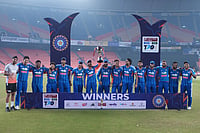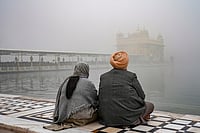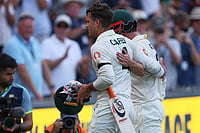"Talcum nahin, condom. Raat bhar theka, subha flush mein phenka."
Kaante
"Dost Nahin hai tu, raand hai tu. Jahaan paisa dekha chipak jati hai."
Paanch
Maa aur sex ke baare sochne se hi tension hai ... Hum kya aasman se tapke?
Waisa Bhi Hota hai
When the going gets tough for the underdog in Hindi movies these days, he is no more very dainty with his expressions. So when Mark (Sunil Shetty), a bouncer-turned-petty criminal, lands up in prison with five others for a crime he never committed in the Sanjay Gupta scorcher Kaante, he quips wryly, "Kismat woh chhinal hai jo mere saath nahin soti (destiny is a prostitute who doesn’t sleep with me)." This is the way Bollywood characters blame it on their karma these days. And many, many more such abrasive dialogues from Kaante are now the talking point amongst moviegoers and critics—quite like the legendary lines in Ramesh Sippy’s Sholay. Only, the trail-blazing gutterspeak of the six mean men bears little resemblance to Gabbar’s all-time favourite "kitne aadmi the" grunts.
Like it or not, Bollywood’s most fabled bandit’s invectives are passe. A whole new generation of young filmmakers is spicing up their scripts with colourful language and trenchant talk. Humdrum dialogues are now peppered with cusswords, be it in the schizophrenic world of Deewangee, or in the gaiety of a Monsoon Wedding. Even our perennially noble heroines are getting a makeover beyond their wardrobes and get-up. In Gunaah, Bipasha Basu as the macho, gun-toting, criminal-smashing tough cop uses expletives as liberally as lipstick. And in Bengal, Rituparno Ghosh has shocked the bhadralok by possibly becoming the first filmmaker to use unprintable khistis (abuses) in his Sharmila Tagore-Rakhee-starring whodunit Shubho Mahurat.
The swear-without-a-care trend took off with Shekhar Kapur’s Phoolan Devi saga, Bandit Queen, but went mainstream only with Ram Gopal Verma’s gangland melodrama Satya. Now it’s hitting our ears and sensibilities harder. At times over-the-top and vulgar, not all of these moving pictures make sound sense. But that’s no reason to goad the censor board to sanitise scripts. Set aside the time-worn debate about morality, sensationalism and titillation, and what you hear is a new voice of cinematic evolution. "It’s a shift that was long needed," says filmmaker Anurag Kashyap whose censor-struck, rough-talking, gut-wrenching Paanch will hit theatres this month-end. Following closely are some other vibrant experimentations with the spoken word—Padam Kumar’s take on youth and materialism, Supari, and Shashanka Ghosh’s Waisa Bhi Hota Hai which has a script and dialogues so different that "dubbing artistes kept dismissing them as crap," says Ghosh.
Graphic language helps ground these films in gritty realism and holds the promise of fresh stories and expressions. So, instead of the rosy diasporic dreams, the new foul-mouthed films take us into the darker alleys of rootless youth, urban violence, underworld machinations, crumbling marriages and even NRI dystopia. Media commentator Sudheesh Pachauri calls it the arrival of a new subculture. "The abuses behind the facade of middle-class morality are now coming upfront. It’s a discourse against fundamentalism," he says. So with its acerbic patois, the hugely mainstream Kaante manages to celebrate negative values like failure and distrust. Brutality gets packaged in pungent black humour and offensive jokes intercut bloody shootouts. In fact, dialogues "become" violent while the physical violence itself gets inventively choreographed, almost like an opera. The inspiration, obviously, is a Scorsese, a Tarantino or a Danny Boyle. "Our socialist realism is giving way to American realism through the gangster lingo," says sociologist Shiv Vishwanathan. So, the crudity and obscenity apart, the ultimate feel is very hip.
Filmmakers themselves consider the changing speech rhythm an effort to get closer to reality. "The idea is not to write dialogues at all," says Kashyap. So heavy dialogue tailored around a Raj Kumar or Amitabh Bachchan, the Urdu influences and even the Bambaiyya tapori-speak are giving way to real-life talk. One that’s free-wheeling, unstructured, accented and often a mix of languages. "It’s the way you and I talk," says Ram Madhvani, director of Let’s Talk, a conversational film on a crumbling marriage. "Characters don’t just speak at each other but also listen patiently," says Vishwanathan. In today’s globospeak, the F word jostles easily with a "phat gayee". "There are no page-long monologues but witty, pointed, crisp lines," says Milap Zaveri, dialogue writer of Kaante. He’s now working on something entirely different but just as non-filmi—a tale of three, young, music-loving city-slickers, a film called Jhankaar Beats. "We’ve used most unassuming lines in Hinglish," says Zaveri.
So the language is trying to keep up with with the protagonists, be it the youth, the lumpen or the social dropouts. They are getting defined as much by their speech as by their mannerisms. "We have till now shown a character from the street talking as though he had done his PhD in Urdu," says filmmaker Vikram Bhatt. Not any more. Padam Kumar’s Supari, for instance, is replete with one-liners a la Dil Chahta Hai youthspeak: "Life mein ek funda achchi tarah se samajhlo...jis cheez ko jitna waste karoge woh utna zyada milegi (Just get one funda clear in life...whatever you waste the most is what you’ll get the most of)." Waisa Bhi Hota Hai has an upmarket copywriter and a hitman coming together and hence tremendous scope for word interplay. "In a city, there can be no barriers of language or culture. It is an equaliser," says Ghosh. Paanch is about the angsty subculture of urban youth. It’s about sex, drugs, hard rock and the perversion around it which gets reflected in the sexual innuendoes intrinsic to the vocabulary of the characters. "I decided not to hide the profanities between the dialogues," says Kashyap. So if a character feels horny, he does not talk vaasna or hawas but expresses it with a crude "tharak chadhi thi". Much like Nagesh Kukunoor’s Hyderabad Blues where masturbation finds a homespun expression: "Dil pe mat le yaar haath mein le (don’t take it to heart, take it in hand)."
Such ease and casualness hold a mirror to the rebellious, reckless sensibility of the makers themselves. "The formal age is over. The new speak is because India is changing from being formal to becoming informal," says Madhvani. "So the use of sexual terms is natural. It’s not to provoke lewd reactions but more in humour," adds Ghosh. "Cusswords are like telegrams that pithily establish relationships, signify friendships," says Vishwanathan.
The censors also seem to be listening. But its guidelines are still fuzzy. The word "chutiya" is still a big no-no though a "bc" slips by in Monsoon Wedding, as it liberally did in Bandit Queen. A reference to masturbation ("haathgadi chalayega kya (want to drive your handcart?") in Paanch was found objectionable but escaped notice in Hyderabad Blues. "They need to understand the genre and the context of the language," says Zaveri. Actually, the censor board seems to have decided that any invective is fine if the film is in English or is produced in the West (Monsoon Wedding, Bandit Queen).
Are we, the audience, any different? We accept everything from Hollywood but cringe at ethnic abuses in Bollywood films. A Kaante remains a peer-group, stag party film rather than a universal success. Will these films ever touch a common chord? Will the independent voice hold up to the so-called wholesome, healthy, family entertainment? We’re all ears.
By Namrata Joshi With Manjira Majumdar in Calcutta





















